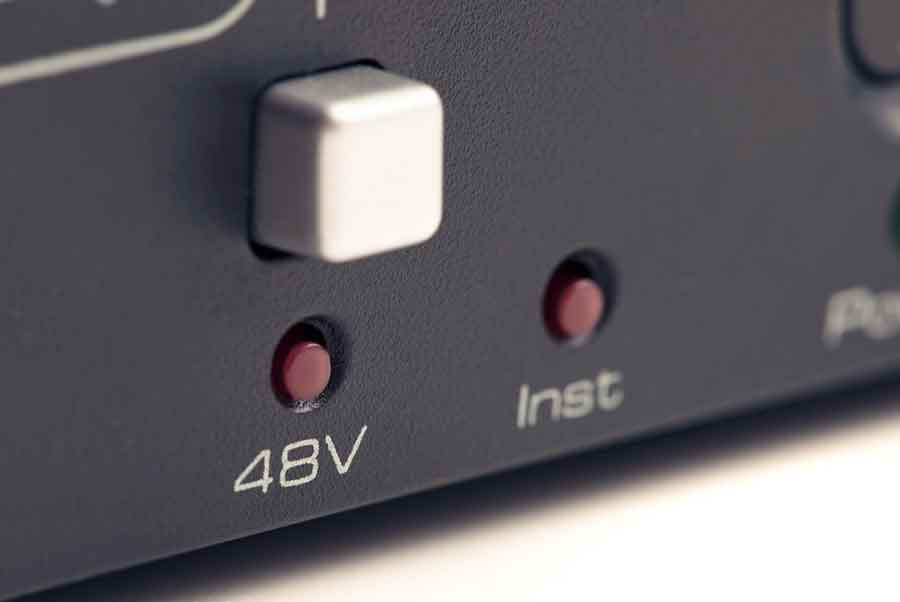In the field of professional sound production, you’ll be hearing the term “phantom power” a lot when you start using a microphone for podcasting, recording in your very own home studio, live streaming, or even filmmaking. But what does it really do?
First, you’ll need to familiarize yourself with the different kinds of microphones, particularly the condenser microphone, as it is known to utilize phantom power the most. Once you’re more familiar with it, it’s much easier to understand what phantom power is and how it works to power microphones.
What Is Phantom Power?

Phantom Power, also known as +48V, is DC electric power sent through audio cables to operate microphones with active electronic circuitry. It’s most popularly known as a convenient power source for condenser microphones, which need this type of power to operate their internal circuitry.
The word “phantom” comes from the idea that the power “hides” in the very same cables that carry the audio signals, instead of needing a separate power cable. Used interchangeably with idle current, vampire power, and standby power, it also refers to the energy consumed (and wasted) by appliances and electronics that are powered off or on “sleep” mode but are still plugged into a power outlet.
While phantom power is one of the most convenient technologies in the music industry today, it was actually discovered by accident in 1966 when professional recording microphone manufacturer Neumann GmbH was contracted by the Norwegian Broadcasting Corporation to supply transistorized microphones that could run off of their studios’ 48V power supply, which had been powering their emergency lighting systems.
The new microphones (KM 84) that Neumann had presented became the origin of 48V and the solution later became the DIN standard 45596. Today, 48V is considered standard, but operating voltages commonly range from 9V up to 48VDC.
Why Do Condenser Microphones Need Phantom Power?
Phantom power, or battery power, is usually needed for condenser microphones because this type of microphone works like a capacitor, as opposed to a dynamic microphone that doesn’t have active circuitry and can generate electricity on its own through electromagnetic induction (like a loudspeaker in reverse). You can learn more about their differences here.
Inside a condenser microphone is a piece of metal (diaphragm) that needs a constant supply of +48 volts to be able to store sound vibration energy from its two surrounding plates before finally converting it into electric signals.
This signal and power transmission concurrently take place through the same cable conductor, and this is made possible only when it’s connected to compatible external audio devices. Phantom power supplies are usually built into:
- Analog/digital mixing consoles
- Mic preamps
- Audio interfaces
- Separate units
- Instrument amps with XLR input
As you can imagine, it’s not only the cable that serves a double purpose but also many audio receivers, as they are often capable of providing the required phantom power on top of performing their primary functional purposes during live audio sessions and recordings.
How Does Phantom Power Work?

The need for phantom power supply makes condenser microphones a bit more complicated to use. Instead of being a plug-and-play device like the typical dynamic mic, you have to make sure that your condenser mic has a power source.
On your chosen compatible external audio device, you have to find and press/click the button or switch (often labeled “P48” or “48V,” if not “phantom”) to turn the power supply on and off. This is after plugging your phantom power microphone in so it doesn’t make loud, popping sounds.
A phantom power cable has a balanced three-pin XLR connector or, in case of a 9V supply, a jack plug rather than an XLR.
- Pin 1: 0 Voltage (ground)
- Pin 2: Positive Voltage (audio in-polarity)
- Pin 3: Positive Voltage (audio opposite-polarity)
You may be able to plug a dynamic and ribbon microphone into a phantom power supply as these other types of microphones connect to Pin 2 and 3, which offer a balanced voltage and therefore do not let any current flow through.
However, it’s not always safe to do so. When one terminal of the coil (in a dynamic microphone) or the ribbon (in a ribbon microphone) gets shorted to the grounded mic housing, the current will flow through and damage the internals of your dynamic or ribbon microphone. This is why it is still advisable to only use phantom power for condenser microphones.
The most common requirement for phantom powering is 48V, but you should check your condenser microphone’s required voltage range to ensure working compatibility between your microphone and audio device. And if your condenser microphone is the type that can also be powered by batteries, it’s best to remove them before using the phantom power to avoid damaging the batteries.
Best Phantom Power for Microphones

If a mixer or amplifier doesn’t feature 48V, there are separate external phantom supply units available in the market. Fortunately, Adorama carries many standalone units that both newbie and professional audio producers are currently using with their phantom-powered microphones. Check them out below:
- Sanken P-11x-PT ()
- Behringer Micropower PS400 Ultra-Compact ()
- Deity Microphones D-XLR Adapter for V-Series Microphones ()
- Ambient Recording Universal Microphone Power Supply ()
- Beyerdynamic MA-PVA Adaptor with Mini-XLR 4pin Input ()
- Whirlwind Micmute Foot Pedal Microphone Muting Box ()
- Yamaha MG20 20-Input 6-Bus Mixing Console ()
You can check out the other phantom supply units that we have here.






